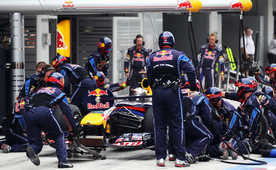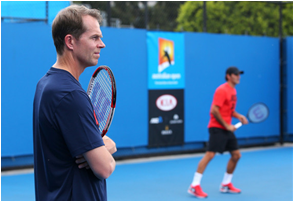An F1 pit-stop team are often considered the epitome of lean. Why? Well, they have many of the hallmarks of a lean & continuous improvement approach. They are customer focused, share a common goal and aim to create a value adding, standardised and optimised process. People are organised, engaged, highly motivated and feel part of a bigger purpose that challenges the status quo. They have targets and are always looking for the next improvement or edge to outperform the competition using a scientific approach, for personal pride, the team and customers.
This is the same kaizen spirit, mind-set, focus and attitude all companies strive for and this teamwork and PDCA improvement approach to continuous improvement is the envy of many companies aiming to emulate this success and create a high performance culture with consistently improved results.
Having a goal for the pit-stop and then understanding what is value added (VA) work and what is non value added (NVA) work at this micro level helps to continually highlight opportunities for improvement by challenging the status quo. Focusing on and striving for only value added activity helps to shave off those all-important micro seconds to drive down time. The goal of course being to win the race and provide that competitive advantage, because in this environment it’s about seconds, not minutes or hours and it could make all the difference.
Experimenting with different ideas, practicing, training and learning what creates the best result is what improves performance and close the gap on the next goal. When you think about it, if you solve the problems at this level it positively affects the results at the top level where Managers are interested. Maybe there is a lesson here as to where management should focus their effort…supporting value adders to add value not just counting the numbers? As the saying goes, you can’t fatten pigs by weighing them!!
So, is an F1 pit-stop lean?
Well, it is in fact a matter of perspective and this is often revealed whenever we show this picture in our training as it sparks a lot of conversation. Everyone sees with different lenses and has a different set of filters, mental assumptions and paradigms about how they look at situations based on their conditioning and programming i.e. one perspective (looking at the photo above) is that this couldn’t possibly be lean as there are too many people. Their own paradigm thinks lean is a cost reduction tool and totally misses the point about the bigger purpose and real goal of winning the race. The need drives the change and in this case, the need or goal to get the car back on the track under 2 seconds determines the no. of people and is therefore relative and balanced to achieving this goal. So, when defined from a ‘value for the customer’ perspective, the outcome is much different from a pure silo, one dimensional resources or cost perspective.
However, other views may think its lean because this process is clearly the result of doing what is commonly known as kaizen i.e. many small process improvements towards a goal. This is true however, kaizen is only step 5 in the 5 lean principles prescribed by Womack & Jones in the book Lean Thinking. So, optimising this process is key and getting to this high performance team maturity and state is a key enabler of lean, but companies also need to look at the bigger picture and go through the first 4 steps of the 5 lean principles before drilling down to this micro level of improvement. Looking at the 20,000 ft broader vision, purpose and overall processes to identify key areas of strategic advantage should be done before diving in at the lowest level. In this example, clearly the pit-stop process would be just one of many kaizen activities and should follow a clear understanding of what value is for the customer, analysis of the overall value stream, making the process flow better, creating pull and then finally to kaizen or continuous improvement and constant PDCA cycles.
In fact, if you take a step back for a moment, the pit-stop is effectively a micro level kaizen and is the equivalent of making a machine changeover quicker or reducing the cycle time of a single task in a single value stream within a business. It is an important part of the system but not the only part and if this was the only focus, a lot of potential opportunities would be left on the table.
Other key areas of the bigger picture is the F1 car itself for example i.e. trialing and testing specific performance improvements, refining these through scientific experiments, engineering changes and feedback from consultation with the driver. It could be tyres, engine, gearbox, acceleration, power to weight ratio, aerodynamics and a whole host of other performance enhancing criteria and attributes that would be measured. Essentially, this is also another kaizen with a PDCA approach to scientifically experiment with all the variables and factors, to find the best combination for the best results.
In addition, having the best drivers in peak condition mentally, physically and emotionally. This may breakdown to specific goals to test for vision, alertness, concentration, focus, stamina, fitness levels or to be a certain weight for races, and any other areas of performance that matter for high performance, elite drivers to gain the edge.
In any business, when you look through a wider lense and set a vision, establish key goals for the next 3-5 years and deploy the current year’s goals using strategy deployment it can focus in on the priorities and must do goals. It creates purpose, aligns and engages everyone to the challenges and people start to problem solve to close the gaps in performance. When you look ‘end to end’ to find the biggest areas for competitive advantage and then find specific areas to focus on with goals, it can really drive a business forward.
What we do…
At Lean Leadership Coach we bring a SYSTEM approach to improving PERFORMANCE and RESULTS to guide thoughts and conversations i.e. focus on CUSTOMERS and what they want, understanding and communicating the overall PURPOSE (Vision, goals, strategy of the business and deploying these to align and engage people to the direction and challenge), look at the big picture PROCESSES and value streams to find opportunities for improvement, as well as empowering and supporting PEOPLE to be their best, align them to the direction of the business and set goals and challenges for the team to meet.
As the goals are set, this naturally creates the ‘gaps in performance’ to solve the problems and it creates a pull on resources to meet the goals and we provide the right tools and techniques, strategies and approaches to help ‘close the gaps’. So, lean is not just about the improvements themselves but the supporting management system i.e. creating the right environment to make problems and opportunities visible, creating a team culture for challenging the status quo and developing a system to support, measure and sustain performance led with the right leadership behaviours.
In summary, zooming into the detail of how value is added and improved against a goal at a team level is essential to competitive advantage, but ensure you also zoom out to see the bigger picture at play that will improve performance and results in all areas towards the bigger vision and goals of a business…
If you need any help in creating a kaizen mindset and approach or want to look at things more strategically please feel free to get in touch.



